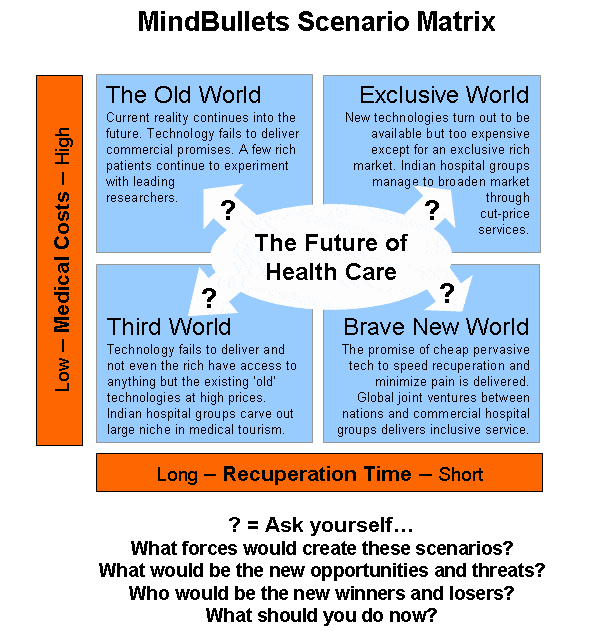
MORE HEALTHCARE BUT FEWER HOSPITAL BEDS

Industry in turmoil as rules-of-the-game change
- Dateline
- 12 June 2015
The Johns Hopkins Hospital Group, recently ranked number one in the United States for the 20th consecutive year, yesterday released plans for a massive restructuring program.
Over the next decade Johns Hopkins plans to shed 50% of its hospital beds despite the fact that the number of patients they handle are expected to treble.
“We will be delivering our new distributed healthcare model with a large number of high-tech local clinics. By the end of the next decade only three of our large hospitals will remain in the US.”
It’s difficult to remember the days when routine surgery required long hospital stays. Although it was just twenty years ago, today’s medical realities have eclipsed all those bad memories.
Almost all but the most severe procedures are now handled as same-day services. Most routine operations are completely painless – apart from occasional psychological stress.
It all started in the 1990s with the advent of keyhole surgery and has advanced along with major new pain treatments and surgical assistants – mostly nano-scale medical robots.
The CEO of India’s Apollo Hospitals, a global partner of Johns Hopkins, agrees: “We have doubled our patients over the past three years but have not increased our hospital beds.
We are focused on achieving extremely high quality levels by cutting recuperation times by up to 75%. Our strategy is to turn recovery into a first-class holiday experience.”
ANALYSIS >> SYNTHESIS: How this scenario came to be
1986: Advent of keyhole surgery
Keyhole surgery (when natural body openings are not used) also called ‘laparoscopic surgery’, band-aid surgery, or minimally invasive surgery (MIS), is a surgical technique pioneered by Dr. Camran Nezhat in 1986, and is intended to minimize operative blood loss and post-operative pain, and speeds up recovery times. It is now extensively used world-wide with exactly those results.
2001: Surgical robots
Breakthroughs in micro-engineering and remote connectivity enable surgical procedures to be performed that would be impossible for unassisted human surgeons.
The same technology also allows these to be performed at a distance with only less-qualified doctors or medical orderlies in attendance. The US Army is at the forefront of these technologies and employs them extensively in remote and hostile areas of conflict.
The first transatlantic surgery (Lindbergh Operation) is performed and is a laparoscopic gallbladder removal. On 7 September 2001, working from New York, Professor Jacques Marescaux and his team from the IRCAD (Institute for Research into Cancer of the Digestive System) performed a successful operation on a patient located in Strasbourg, France.
2002 to 2005: Improved pain management
Pain management is the discipline concerned with the relief of pain. According to Lilley, Harrington, and Snyder pain is most commonly described as, “An unpleasant sensory and emotional experience associated with either actual or potential tissue damage. It is a very personal and individual experience – defined as whatever the patient says it is, and it exists wherever he or she says it does.” (Lilley, L. L., Harrington, S., & Snyder, J. S.; 2005. Pharmacology and the Nursing Process. 4th ed., pp. 147. St. Louis: Mosby.)
Acute pain, such as occurs with trauma, often has a reversible cause and may require only transient measures and correction of the underlying problem. In contrast, chronic pain often results from conditions that are difficult to diagnose and treat, and that may take a long time to reverse. Some examples include cancer and arthritis. In such situations, the pain itself is frequently managed separately from the underlying condition of which it is a symptom.
During the first years of the 21st Century major new approaches to alleviating pain during and after operations were developed so that, even after major surgery, patients have no sensation of pain and are able to return to their normal lives almost immediately.
2010: Medical nano-robots
Nano-technology applied to medicine has become a large-scale commercial reality.
Nano-robots are now routinely injected into the bloodstream to monitor bodily functions and to do roto-rooter jobs on arteries.
Specialized nano-robots assist doctors in complex diagnosis, suturing and act as surgical assistants.
2012: Commercial organ cloning
The Apollo Hospitals Group is the single largest private hospital group in Asia and is now at the forefront of commercial organ cloning from stem cells. While the rest of the world is fighting about the ethics of stem cells, this Indian corporation has waiting lists of more than six months for procedures to clone pancreas, liver and nerve cells. They believe that within ten years they will be able to grow a replacement heart on demand.
Their success has put US and EU hospitals in a quandary. Even if regulatory approval is accelerated the costs of doing similar procedures in their markets will be at least double current Apollo prices – and they have set their prices fairly high due to the high demand.

Links to related stories
- MindBullet: DIGITAL DOCTOR'S FIRST CALL (Dateline: 12 September 2009, Published: 15 April 2004)
- MindBullet: BABY BOOMERS TIP USA HEALTHCARE INTO CRISIS (Dateline: 3 January 2010, Published: 30 September 2004)
- MindBullet: THE #1 DESTINATION FOR MEDICAL TOURISM: INDIA (Dateline: 12 February 2010, Published: 30 June 2005)
- MindBullet: GROW YOUR OWN TEETH, LIVER, PANCREAS & HEART (Dateline: 15 May 2012, Published: 08 July 2004)
- The NanoMedicine Revolution: NanoDocs - Dwayne Medical Centre
- NanoRobotics - Wikipedia
- Apollo Hospitals Group web site
- Johns Hopkins International web site
Warning: Hazardous thinking at work
Despite appearances to the contrary, Futureworld cannot and does not predict the future. Our Mindbullets scenarios are fictitious and designed purely to explore possible futures, challenge and stimulate strategic thinking. Use these at your own risk. Any reference to actual people, entities or events is entirely allegorical. Copyright Futureworld International Limited. Reproduction or distribution permitted only with recognition of Copyright and the inclusion of this disclaimer.